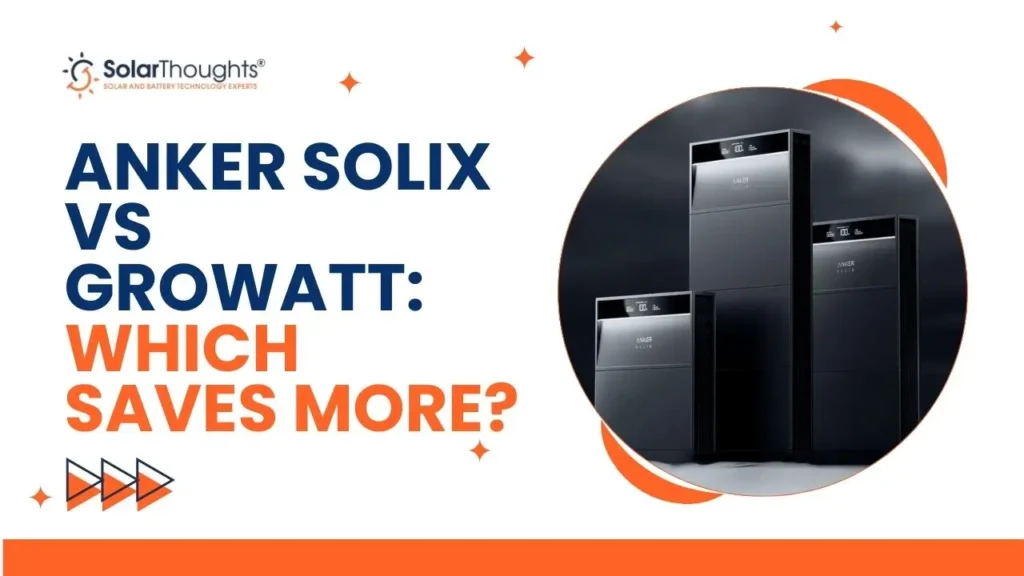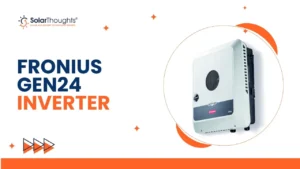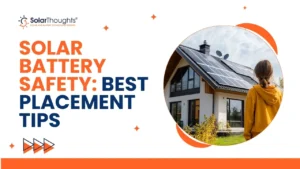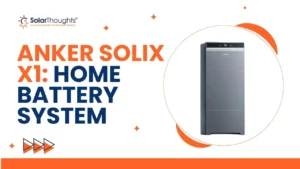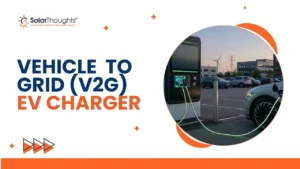Efficiency ratings might catch your eye as you compare Anker Solix and Growatt solar power systems. Growatt solar inverters achieve efficiency ratings up to 99%, while Solis models reach 98.8% efficiency. These high-performing devices convert DC electricity from your solar panels into usable AC electricity that powers your household appliances.
Table of Contents
ToggleSolar inverters revolutionize the way you employ renewable energy. The Anker SOLIX F3800 Plus comes with an expansion battery and delivers 6,000W AC output – enough power to run your entire home during blackouts. Growatt backs their inverters with a 10-year warranty to protect your investment. Both manufacturers’ inverter technology produces stable sine wave output with minimal harmonic distortion, making their devices safe for sensitive electronics like laptops, cell phones, and medical equipment.
Your choice of inverter will affect both immediate costs and future savings. This detailed comparison will get into how these industry leaders match up in technology, efficiency, and warranty coverage. Most importantly, you’ll learn which option saves you more money.
Brand and Technology Overview
Company Background: Anker Solix vs Growatt
Every solar inverter reflects its company’s vision and technical approach. Growatt, a 13-year-old company, has earned its place as a respected name in renewable energy. This Chinese manufacturer focuses on solar inverters and has built a reputation for affordable and reliable solutions in both homes and businesses. The company’s global reach has grown substantially, and Australian customers know them for their budget-friendly and accessible products.
Anker Solix is the solar division of Anker Innovations that uses its parent company’s consumer electronics expertise to create state-of-the-art solar solutions with built-in battery systems. Anker, founded in 2011, is already a global leader in charging technology, trusted by over 150 million users across 140+ countries. It has been ranked the No. 1 mobile charging brand worldwide for three consecutive years (2020–2022). This strong track record in battery and charging innovations is now shaping the SOLIX product line for renewable energy solutions.
Inverter Types: Hybrid, String, and Off-grid Options
These manufacturers offer different inverter configurations that match various solar setups:
Growatt’s three main inverter categories include:
- String inverters (like MIN 2500-6000TL-XH) that reach efficiency ratings up to 98.4%
- Hybrid inverters (GROWATT 3000-6000TL3-s) that merge solar power with battery storage
- Larger capacity models (7000-11000TL3-S) are perfect for big homes or small business setups
Hybrid inverters combine a solar inverter and battery inverter into one unit that manages power smoothly between solar panels, batteries, and the grid. Off-grid inverters work without connecting to the utility grid and draw DC power only from battery sources that solar arrays charge.
Technology Base: LFP Batteries vs Traditional Inverter Design
These systems’ technology shows distinct differences. Growatt’s batteries use Lithium Iron Phosphate (LiFePO4) technology that offers better thermal stability, longer life, and improved security compared to standard lithium-ion batteries. The LFP batteries are a big deal as it mean that they achieve over 90% round-trip efficiency and last through more than 3,000 charge cycles.
Standard inverter designs typically run at lower efficiency, but Growatt’s modern string inverters reach 98.4% efficiency through advanced MPPT controller technology. Their smart energy management systems also provide immediate performance tracking and remote control. Users can optimize their energy use patterns effectively.
Performance and Efficiency Metrics
Technical specifications play a key role in determining which solar inverter performs better in real-life conditions. Let’s get into how Anker Solix and Growatt stack up against each other on critical metrics.
Conversion Efficiency: 98.4% vs 98.8%
Efficiency ratings show how well an inverter converts DC power from solar panels into usable AC electricity. Growatt solar inverters reach a maximum efficiency of 98.4% and minimize energy loss during conversion. But Solix models perform slightly better with efficiency ratings up to 98.8%. Most modern residential inverters work at 95-98% efficiency, which puts both brands in the premium category.
MPPT Capabilities: Dual vs Triple Trackers
Maximum Power Point Trackers (MPPT) are circuits that maximize available energy from connected solar modules. We tested dual MPPT systems and found they work better than single MPPT setups in most applications with two or more strings. Multiple MPPTs come with clear benefits:
- Different solar arrays can work independently while facing various directions
- Performance stays optimal even with partial shade on some panels
- Different string lengths or panel types work together seamlessly
This independent operation helps produce more energy, especially when panels get different amounts of sunlight.
Thermal Management: Passive Cooling vs Active Heat Sinks
Thermal management makes a huge difference in how long inverters last and how well they perform. Passive cooling uses natural convection, conduction, and radiation through components like heat sinks. This method brings several advantages:
- Simple and economical solutions
- Zero extra power needs
- No maintenance required
Active cooling systems need external power sources like fans to control heat. These systems get pricey and complex but handle temperature better in high-performance setups.
Cost and Warranty Comparison
Money plays a crucial role when choosing between solar inverter brands. Let’s get into how these two manufacturers match up on price and long-term protection.
Upfront Cost: Growatt vs Anker Solix Pricing
Growatt stands out as a budget-friendly choice that manages to keep decent efficiency ratings. Their inverters cost less than premium brands like Fronius and SMA. Some installers say Growatt’s units cost about half of what you’d pay for high-end options.
You’ll need more money upfront for Anker Solix systems, but their advanced features might make the higher price worth it.
Warranty Terms: 5-10 Years vs 10-25 Years
Growatt backs their inverters with a 5-year warranty that you can stretch to 10 years. Their battery systems come with a 10-year warranty, promising at least 60% capacity when the warranty ends.
Anker Solix takes it further with their battery systems. They offer a 10-year warranty and guarantee 70% minimum capacity at the warranty end. This better capacity retention could save you money over time.
Installation and Maintenance Costs
The purchase price isn’t your only expense. Swapping out an old inverter runs about AUD 4586.97 with installation. Commercial setups need yearly maintenance that costs between AUD 458.70 and AUD 1070.29.
Smart owners get regular professional checkups to avoid emergency fixes that can run over AUD 1528.99 per whole ordeal. A well-maintained system pumps out 12-15% more energy each year than a neglected one, which boosts your investment returns.
Anker Solix vs Growatt: Comparison Table
| Feature | Anker Solix | Growatt |
| Maximum Efficiency | 98.8% | 98.4% |
| AC Output Power | 6,000W (F3800 Plus model) | Not mentioned |
| Battery Technology | Not specified | LiFePO4 (Lithium Iron Phosphate) |
| Battery Capacity | 5kWh to 180kWh (expandable) | Not mentioned |
| Transfer Time | 10ms | Not mentioned |
| Standard Warranty | 10 years | 5-10 years |
| Battery Warranty Capacity Retention | 70% at the end of the warranty | 60% at the end of the warranty |
| Monitoring Platform | SOLIX Professional app | ShinePhone app with AI predictive maintenance |
| Cooling System | Not mentioned | Offers both passive and active cooling options |
| MPPT Configuration | Not mentioned | Multiple MPPT trackers are available |
| Price Position | Higher original investment | More budget-friendly option |
| Grid Connection Options | On-grid and off-grid capability | String, hybrid, and off-grid options |
Why Our Company Recommends Anker Solix
Based on the milestones and product roadmap, our company inclines towards recommending Anker Solix solutions to customers. Here’s why:
- Proven brand trust: Over a decade of innovation in battery and charging technology.
- Scalable storage: Expandable battery capacity from 5kWh up to 180kWh, making it suitable for households of all sizes.
- Future-ready power: Models like the SOLIX Solarbank and F3800 provide whole-home backup, RV power, and even EV charging support.
- Durability: 10-year lifespan with 70% battery capacity retention at warranty end.
- Energy independence: Seamless solar + grid + portable charging integration that keeps homes powered even during outages.
In short, while Growatt offers affordability, Anker Solix provides long-term value and reliability. For customers seeking sustainability, advanced storage, and future-proof energy independence, we recommend Anker Solix.
Conclusion
Your choice between Anker Solix and Growatt inverters comes down to your energy needs and budget. Both systems are highly efficient. Solix performs slightly better at 98.8% while Growatt runs at 98.4%. This small difference adds up to substantial savings as time goes by.
Growatt costs about half as much as premium options. Anker Solix makes up for its higher price tag through better battery capacity retention (70% vs 60%) and a longer warranty. This could mean better value in the long run.
The best choice becomes clear once you look at what you need. Growatt works great for homeowners who want solid performance without premium costs. On top of that, its LiFePO4 battery technology offers great thermal stability and lasts longer. Anker Solix shines if you need peak efficiency, more storage (up to 180kWh), and backup power with its quick 10ms transfer time.
The money you save goes beyond the purchase price. These systems can cut your power bills quite a bit. Homes with solar panels already installed save up to AUD 1,681.89 each year. New complete installations could save even more – up to AUD 3,516.68 yearly.
Growatt gives you better value right now. Anker Solix might save you more money over the typical 7-10 year payback period. The right choice depends on what matters more to you – spending less now or getting better efficiency over time. Whatever brand you pick, both options will help you become energy independent and cut your power bills for years.
Our Popular Services
Top-rated solar panels company in Brisbane | Solar Panel Installation in Gold Coast | Upgrading existing Solar system | Solar Panel Repairs and Maintenance | Solar Panel Cleaning Service | Solar Battery Installations | Solar Inverter Installations

